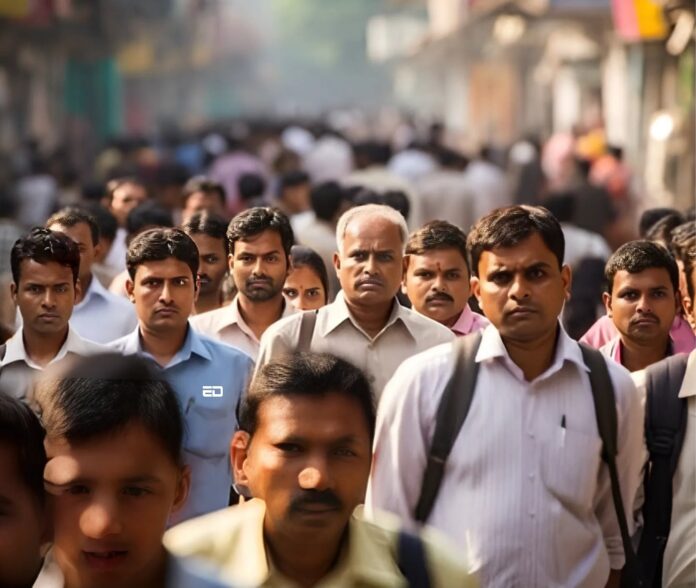India surpassed China to become the most populated country in the world, having over 1.45 billion people.
Overpopulation has always been a concern. Resources are limited and a population surge implies further difficulty in their just and equal allocation among people.
For example, India is also the nation with the maximum number of youth, yet it has not been able to solve the problem of unemployment.
However, it is also important to look at the distribution of this population. While India is dealing with overpopulation, it is also fighting with its unequal distribution that leads to problems such as declining fertility rates in some states, an increasing elderly population and thus, limited working-age people.
Here’s a clear picture of the crisis some Indian states are growing through.
Why Is The Ageing Population Increasing In The Country?
India has been promoting family planning measures through campaigning and catchy phrases such as “hum do, humare do” (encouraging a family unit made up of two parents with two children) for decades. But now, it is facing the problem of a fast-growing ageing population, and thus a declining youth in some states.
The fertility rate, defined as the average number of children born to women during their reproductive phase, has been declining in India’s southern and smaller northern states.
The Office of the Registrar General of India revealed that while states such as Tamil Nadu, West Bengal, Telangana, Andhra Pradesh and Kerala faced fertility rates of 1.4 to 1.5, states like Bihar, Uttar Pradesh and Madhya Pradesh recorded fertility rates between 2.6 and 3, from 2019 to 2021.
This unequal population distribution is turning out to be problematic for the country. A report released by the United Nations in September 2023 showed that India’s elderly population, that is people above 60 years of age, will grow by a whopping 41% between 2021 and 2031. The report also added that the number of elders will outgrow the number of children (people below 15 years of age) by 2046.
These numbers highlight the drop in female fertility levels below replacement level, leading to a premature ageing population.
What Are States Doing About It?
An increase in the ageing population in India can become a barrier to the economic growth the country is aiming for. The decline in the number of people able to work in some states is coming hand-in-hand with a surge in elderly people, who demand more welfare schemes and pensions. This imbalance implies spending will surpass revenue in these cities.
Andhra Pradesh is a state that is already grappling with this issue. The Ministry of Health and Family Welfare disclosed that the fertility rate in the state reduced to 1.5% as of 2020.
As a solution, its Chief Minister (CM), Chandrababu Naidu took back the two-decade old policy that restricted people with more than two children from standing for local body polls.
“The growth rate in the state should increase. Everyone should think about this, and families should aim to have at least two or more children. In the past, I advocated for population control. The need at that time was different. But now we need to increase the birth rate for the future. The state government is planning to bring a law allowing only people with two or more children to contest local body elections,” the CM said at a meeting in October this year.
Read More: World Population To Decrease For The First Time In Centuries
What Are The Consequences Of A Surge In Ageing Population In The Country?
Countries such as China, Japan, and some in the EU (European Union) are already suffering from a rising population crisis due to the ageing of their populations.
Germany, for instance, has taken up policies, such as reduction in college fees, easy access to visas and offering high-paying jobs, to attract international students to study and work in the country. This is because of the severe labour crunch in important sectors that contribute to Germany’s economy.
There are other repercussions of a falling youth population. With respect to the 2011 consensus, population growth is expected to be much higher in India’s northern states than in the southern ones, implying that the former will have more representatives in the Parliament, thus putting the southern states at a strong disadvantage.
“Today, as we face the possibility of fewer Lok Sabha constituencies, it raises the question: why should we limit ourselves to having fewer children? Why not aim for 16 children?” said the CM of Tamil Nadu, MK Stalin.
The Finance Commission also allocates more tax for states with higher populations. Therefore, Uttar Pradesh received the highest tax allocation, of Rs 31,962 crore, which surpassed even the combined total allocated by the 5 southern states, Karnataka, Kerala, Tamil Nadu, Telangana, and Andhra Pradesh, of Rs 28,152.
At such a point time when political leaders are promoting to have more children “for the benefit of the nation”, activists are raising concerns about the implications on women’s health.
Executive director of the Population Foundation of India, Poonam Muttreja, told The Wire, “Global experience shows that telling women to have more children simply doesn’t work. The number of children a woman has is influenced by many factors such as education, economic opportunities, social context and access to healthcare. It is not a switch that can be flipped at will. Southern states like Tamil Nadu, Kerala, and Andhra Pradesh have achieved lower fertility rates thanks to investments in education, healthcare and women’s empowerment. The chief ministers’ and political leaders’ calls threaten decades of progress in population stabilisation and women’s empowerment.”
An International Monetary Fund (IMF) paper called ‘She is the Answer’ suggests that women can play a major role in fighting the problems of a growing ageing population and a declining workforce.
“Although greater participation by women is crucial for countries regardless of where they fall along the path of demographic transition, for those whose population is rapidly ageing, the female labour supply is indispensable,” wrote the authors, Yuko Kinoshita and Kalpana Kochhar.
Hence, while states in India are mulling over policies to incentivise families to have more children, it is important that these recommendations come with better maternity and childcare facilities, better parental leaves, changes in social attitudes towards girl children and policies that support women.
Sources: The Hindu, The Wire, UNFPA India
Find the blogger: Unusha Ahmad
This post is tagged under: hum do, humare do, India, policy, maternity, childcare facility, women, states, Andhra Pradesh, Tamil Nadu, CM MK Stalin, Yuko Kinoshita, Kalpana Kochhar, labour supply, population, demographic, IMF, She is the Answer, workforce, Population Foundation of India, Poonam Muttreja, The Wire, executive director, southern, Kerala, nation, activists, Telangana, Karnataka, Germany, China, Japan, EU, Lok Sabha, Chandrababu Naidu, Ministry of Health and Family Welfare, October, Office of the Registrar General of India, Madhya Pradesh, Uttar Pradesh, Bihar, West Bengal, overpopulation, fertility rate
Disclaimer: We do not hold any right, copyright over any of the images used, these have been taken from Google. In case of credits or removal, the owner may kindly mail us.
Other Recommendations:
India’s Population Control Measures Won’t Work Unless We Hit Youth With The Real Deal On Sex




























